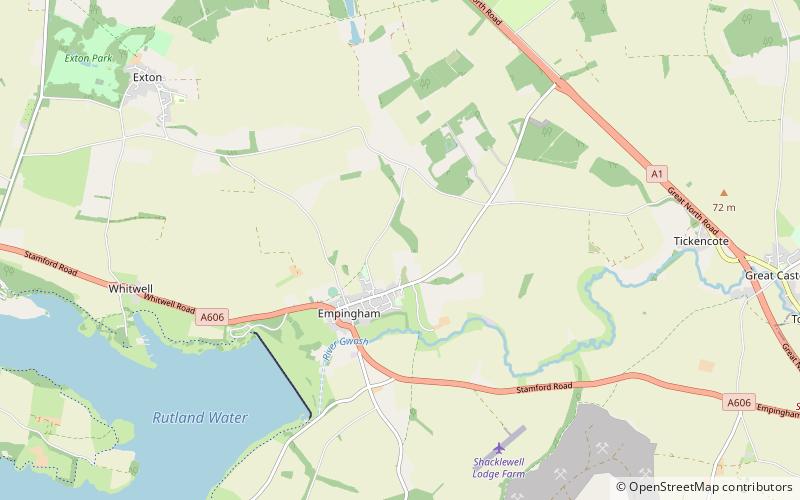Empingham Marshy Meadows, Empingham
#1 among attractions in Empingham


Facts and practical information
Empingham Marshy Meadows is a 14 hectare biological Site of Special Scientific Interest north of Empingham in Rutland. ()
Empingham United Kingdom
Empingham Marshy Meadows – popular in the area (distance from the attraction)
Nearby attractions include: Stamford Town Hall, The Olive Branch and Beech House, Kings Mill, Barnsdale Gardens.
 City hall
City hallStamford Town Hall, Stamford
124 min walk • Stamford Town Hall is a municipal building in St Mary's Hill, Stamford, Lincolnshire, England. The building, which was the headquarters of Stamford Borough Council, is a Grade II* listed building.
 Nightlife, Restaurant
Nightlife, RestaurantThe Olive Branch and Beech House, Oakham
111 min walk • The Olive Branch is a public house and restaurant located in the Rutland village of Clipsham. Clipsham is close to the A1, near Stamford, Lincolnshire. As of 2008, the restaurant holds one star in the Michelin Guide. Beech House, across the road from The Olive Branch, offers six luxury bedrooms and suites.
 Archaeological site
Archaeological siteKings Mill, Stamford
119 min walk • King's Mill is a former watermill on Bath Row, Stamford, Lincolnshire, England, at the bottom of the sloping road called St Peter's Vale. There is said to have been a mill on this site at the time of the Domesday survey, and took the name 'King's Mill' in the time of King John.
 Garden, Cafe, Garden center
Garden, Cafe, Garden centerBarnsdale Gardens, Oakham
74 min walk • Barnsdale Gardens in Rutland, England, were made famous by Geoff Hamilton through the BBC television series Gardeners' World, which he presented from 1979 until his death in 1996. They are on The Avenue in Exton, a short distance north of Rutland Water.
 Church, Gothic Revival architecture
Church, Gothic Revival architectureChurch of St Michael the Greater, Stamford
124 min walk • The Church of St Michael the Greater is a late-Georgian Gothic church in Stamford, Lincolnshire which stands on the south side of Stamford High Street on the site of an earlier, Medieval predecessor. The church is a Grade II listed building as, separately, is the churchyard wall.
 Church
ChurchSt Mary's Church, Stamford
124 min walk • St Mary's Church, Stamford is a parish church in the Church of England, located in Stamford, Lincolnshire, lending its name to St Mary's Hill on which it stands, and which runs down to the river crossing opposite The George Hotel.
 Church
ChurchAll Saints' Church, Stamford
120 min walk • All Saints' Church, Stamford is a parish church in the Church of England, situated in Stamford, Lincolnshire, England. It is a Grade I listed building. The church is on the north side of Red Lion Square which was part of the route of the A1 until the opening of the Stamford bypass in 1960.
 Museum
MuseumStamford Museum, Stamford
123 min walk • Stamford Museum was located in Stamford, Lincolnshire, in Great Britain. It was housed in a Victorian building in Broad Street, Stamford, and was run by the museum services of Lincolnshire County Council from 1980 to 2011.
 Church, Gothic architecture
Church, Gothic architectureSt John the Baptist's Church, Stamford
122 min walk • St John the Baptist's Church is a redundant Anglican church in the centre of the town of Stamford, Lincolnshire, England. It is recorded in the National Heritage List for England as a designated Grade I listed building, and is under the care of the Churches Conservation Trust.
 Historical place, Theater, Concerts and shows
Historical place, Theater, Concerts and showsTolethorpe Hall, Stamford
106 min walk • Tolethope Hall in the parish of Little Casterton, Rutland, England, PE9 4BH is a country house near Stamford, Lincolnshire at grid reference TF023104. It is now the location of the Rutland Theatre of the Stamford Shakespeare Company.
 Church, Gothic Revival architecture
Church, Gothic Revival architectureChurch of St Mary and St Augustine, Stamford
123 min walk • The Parish Church of St Mary and St Augustine in Stamford, Lincolnshire, England, is home to a congregation of the Roman Catholic Diocese of Nottingham. St Augustine's was designed in a "robust High Victorian Early English" style by George Goldie, one of the foremost Catholic architects in England in the nineteenth century.
